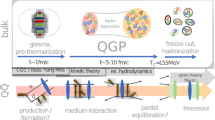Abstract
We present a brief review of the subject of disoriented chiral condensates (DCC). We describe the conventional scenarios for the formation of DCC which have been proposed in the literature. Observable signals, such as fluctuations in neutral to charged pion ratio, are discussed. We then discuss a novel scenario for DCC formation, recently proposed by us, where the entire region of hot partons can get converted into a single large DCC. Our arguments suggest that formation of such large DCC is unlikely in the collision of heavy nuclei, and ultra-high energy hadronic collisions may be better suited for this.
Similar content being viewed by others
References
A A Anselm, Phys. Lett. B217, 169 (1989)
J-P Blaizot and A Krzywicki, Phys. Rev. D46, 246 (1992)
J D Bjorken, K L Kowalski and C C Taylor, preprint SLAC-PUB-6109, presented at the 7th Les Rencontres de Physique de la Vallee d’Aoste: Results and Perspectives in Particle Physics, La Thuile, Italy, 7–13 March 1993
K Rajagopal and F Wilczek, Nucl. Phys. B399, 395 (1993);
Nucl. Phys. B404, 577 (1993)
J P Blaizot and D Diakonov, Phys. Lett. B315, 226 (1993)
C M G Lattes, Y Fujimoto and S Hasegawa, Phys. Rep. 65, 151 (1980)
L T Baradzei et al, Nucl. Phys. B370, 365 (1992), and references therein
M Suzuki, Phys. Rev. D54, 3556 (1996)
S Gavin, A Gocksch and R D Pisarski, Phys. Rev. Lett. 72, 2143 (1994)
D I Kaiser, Phys. Rev. D59, 117901 (1999)
H Hiro-Oka and H Minakata, Phys. Rev. C61, 044903 (2000)
F Cooper, Y Kluger, E Mottola, and J P Paz, Phys. Rev. D51, 2377 (1995)
D Boyanovsky, H J de Vega and R Holman, Phys. Rev. D51, 734 (1995)
D Boyanovsky, M D’Attanasio, H J de Vega and R Holman, Phys. Rev. D54, 1748 (1996)
M A Lampert, J F Dawson and F Cooper, Phys. Rev. D54, 2213 (1996)
S Gavin and B Müller, Phys. Lett. B329, 186 (1994)
M Asakawa, Z Huang and X N Wang, Phys. Rev. Lett. 74, 3126 (1995)
J Randrup, Phys. Rev. D55, 1188 (1997)
D Molnar, L P Csernai and Z I Lazar, Phys. Rev. D58, 114018 (1998)
A Krzywicki and J Serreau, Phys. Lett. B448, 257 (1999)
J I Kapusta, and A P Vischer, Z. Phys. C75, 507 (1997)
J I Kapusta, A P Vischer and R Venugopalan, Phys. Rev. C51, 901 (1995)
O Scavenius and A Dumitru, Phys. Rev. Lett. 83, 4697 (1999)
WA98 Collaboration: T Nayak et al, Nucl. Phys. A638 249c (1998)
WA98 Collaboration: M M Aggarwal et al, Phys. Lett. B420, 169 (1998)
T D Cohen and C K Chow, nucl-th/9903029
Z Huang, I Sarcevic, R Thews and X N Wang, Phys. Rev. D54, 750 (1996)
T D Cohen, Phys. Lett. B372, 193 (1996)
F Cooper, Y Kluger and E Mottola, preprint, LBL-38585 (1996)
Z Huang, M Suzuki and X N Wang, Phys. Rev. D50, 2277 (1994)
V Koch, J Randrup, X-N Wang and Y Kluger, nucl-th/9712061
H Hiro-Oka and H Minakata, Phys. Lett. B425, 129 (1998)
J I Kapusta and A M Srivastava, Phys. Rev. D52, 2977 (1995)
S Digal and A M Srivastava, Mod. Phys. Lett. A13, 2369 (1998)
S Digal, R Ray, S Sengupta and A M Srivastava, hep-ph/9805227, Int. J. Mod. Phys. (in press)
MiniMax Collaboration: J D Bjorken, for the collaboration, hep-ph/9610379
T S Biro and C Greiner, Phys. Rev. Lett. 79, 3138 (1997)
C Greiner, Z Xu, and T S Biro, hep-ph/9809461
Author information
Authors and Affiliations
Rights and permissions
About this article
Cite this article
Srivastava, A.M. Formation of disoriented chiral condensates in relativistic heavy-ion collisions. Pramana - J Phys 55, 53–62 (2000). https://doi.org/10.1007/s12043-000-0083-4
Issue Date:
DOI: https://doi.org/10.1007/s12043-000-0083-4




